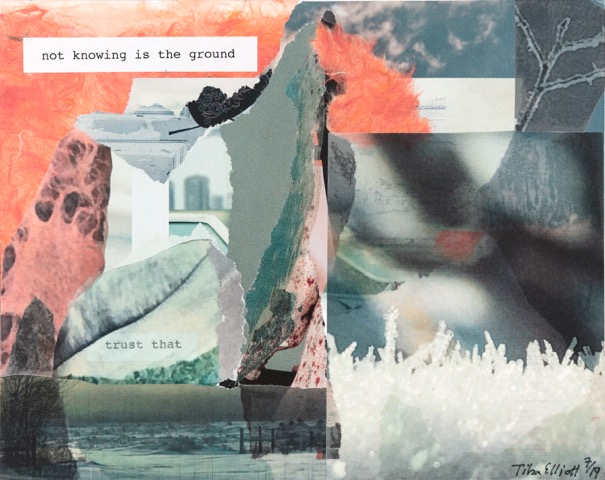Arts & Entertainment
‘Montana Collages’ capture a sense of home
Published
4 years agoon
Posted By
Outlaw Partners

By Michael Somerby EBS STAFF
GALLATIN GATEWAY – When Tika Altemoeller first stepped onto the Bozeman airport tarmac in 2001, she was struck by, of all things, the air. It was so fresh, so pure, tinged with inexplicable notes of Christmas.
The sensation was curious—it felt like coming home, despite the thousands of miles between the Gallatin Valley and her native Germany.
“I remember that air … I was like, ‘Wow, OK. I’m here,” said Altemoeller, setting a fresh cup of herbal tea onto her Gallatin Gateway kitchen table, a worthy companion to a colorful plate of German Christmas cookies at its center. “I’ve always had this feeling of home here, from the very first moment I arrived.”
Today, Altemoeller lives with her husband in Gallatin Gateway, an often-discounted township that in reality—and quite naturally—boasts the very best of both Big Sky and Bozeman. Complete with wide-open spaces, varied terrain, impressive views and plenty of access to the two populations and amenities it splits, sans the incessant crush of out-of-towners, the original spirit of Montana is alive and well in Gateway.
And their home, custom-made from repurposed shipping containers, is tactfully positioned in a sprawling field of grasses to allow maximum synthesis with the environs that cradle it.
It’s there, bordered by aspen groves and the foothills of the Gallatins, Altemoeller’s art has evolved, manifesting into the “Montana Collages.”
“More than anywhere else, I get the feeling that I’m at home here because we built this house, and it was such a cool process to do it,” Altemoeller said. “I was like, ‘I can make collages about Montana with the theme of home.’”
Her first consistent foray into collage began with Japanese-stylized pieces inspired by “Instructions for The Cook,” a roughly 800-year-old text written by Dōgen Zenji, a Japanese Buddhist priest, writer, poet, philosopher and founder of the Sōtō school of Zen.
Those pieces recruited an amalgamation of Japanese characters and magazine cutouts, which Altemoeller cut and shaped with precision.
But with the her most recent series, “Montana Collages,” she worries less about hard edges, focusing on combining texture, original photographs of Montana, color, text and fashion magazine rippings into unique pieces that honor her perceptions.
“I like to just rip it (magazine pages) and see what happens,” she said, underscoring the wildness of the spaces that inspire the pieces. “Sometimes, I’ll see the pieces begin to make a collage on their own on the table.”
For Altemoeller, the process of collecting those intimate imprints of Montana is not complicated—she simply heads out into the abundant landscapes with an iPhone, snapping shots that catch the eye.
“I never pretend I’m a photographer,” she said. “I have my phone, I see things, I take a picture of them.”
Working from a rustic, barn-like studio space roughly a mile from her home, she assembles those snapshots and clippings and words into working compositions—each rendered unique with its own tones and celebrations of Montana.
Even the mundane, such as a street sign and a stop sign, are essential, and the end result is a snapshot of her insight into The Last Best Place.
A stalk of grass; a delicate pile of snow; the crusted metal of a bridge; a field traced by telephone pole lines; these are all worthy features, no matter their inconspicuous presence. To quote a Montana Collage:
home
sky, mountains,
rivers, grass
not this, not that
within
Along with making collages in homage of Montana, Altemoeller is regularly commissioned for custom pieces; for more information and to purchase a collage, she can be reached at tika.altemoeller@gmail.com, her website thestudiotika.com, or via her Instagram account @tikaelliot
The Outlaw Partners is a creative marketing, media and events company based in Big Sky, Montana.


Upcoming Events
april, 2024
Event Type :
All
All
Arts
Education
Music
Other
Sports
Event Details
Children turning 5 on or before 9/10/2024:
more
Event Details
Children turning 5 on or before
9/10/2024: Kindergarten
enrollment for the 2024-2025 school year can be completed by following the
registration process now.
Children
born on or after September 11, 2019: 4K enrollment is now open for
families that have a 4-year-old they would like to enroll in our program for
the 2023-2024 school year. Please complete the 4K Interest Form to
express your interest. Completing this form does not guarantee enrollment into
the 4K program. Enrollment is capped at twenty 4-year-olds currently
residing within Big Sky School District boundary full time and will be
determined by birth date in calendar order of those born on or after September
11, 2018. Interest form closes on May 30th.
Enrollment now is critical for fall preparations. Thank you!
Time
February 26 (Monday) - April 21 (Sunday)
Event Details
Saturday, March 23rd 6:00-8:00pm We will combine the heart-opening powers of cacao with the transcendental powers of breathwork and sound. Together, these practices will give us the opportunity for a deep
more
Event Details
Saturday, March 23rd 6:00-8:00pm
Time
March 23 (Saturday) 6:00 pm - April 23 (Tuesday) 8:00 pm
Location
Santosha Wellness Center
169 Snowy Mountain Circle
Event Details
We all are familiar with using a limited palette, but do you use one? Do you know how to use a
more
Event Details
We all are familiar with using a limited palette, but do you use one? Do you know how to use a limited palette to create different color combinations? Are you tired of carrying around 15-20 different tubes when you paint plein air? Have you ever wanted to create a certain “mood” in a painting but failed? Do you create a lot of mud? Do you struggle to achieve color harmony? All these problems are addressed in John’s workbook in clear and concise language!
Based on the bestselling “Limited Palatte, Unlimited Color” workbook written by John Pototschnik, the workshop is run by Maggie Shane and Annie McCoy, accomplished landscape (acrylic) and plein air (oil) artists,exhibitors at the Big Sky Artists’ Studio & Gallery and members of the Big Sky Artists Collective.
Each student will receive a copy of “Limited Palette, Unlimited Color” to keep and take home to continue your limited palette journey. We will show you how to use the color wheel and mix your own clean mixtures to successfully create a mood for your paintings.
Each day, we will create a different limited palette color chart and paint a version of a simple landscape using John’s directives. You will then be able to go home and paint more schemes using the book for guidance.
Workshop is open to painters (oil or acrylic) of any level although students must have some basic knowledge of the medium he or she uses. Students will be provided the book ($92 value), color wheel, value scale and canvas papers to complete the daily exercises.
Sundays, April 14, 21 and 28, 2024
Noon until 6PM.
$170.
Time
14 (Sunday) 12:00 pm - 28 (Sunday) 6:00 pm
Event Details
Come join us at Cowboy Coffee as we celebrate a fun night of drinks, games, and meeting others within the community. This event is from 6-8 and all are welcome
Event Details
Come join us at Cowboy Coffee as we celebrate a fun night of drinks, games, and meeting others within the community. This event is from 6-8 and all are welcome to come, if you don’t know who to bring come alone this is a great mixer event! This is an event hosted by Big Sky OUT as we work to provide queer safe spaces throughout the community.
Time
(Sunday) 6:00 pm - 8:00 pm
Location
Cowboy Coffee
25 Town Center Ave. Big Sky, MT 59716














